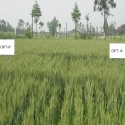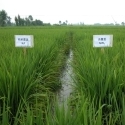13 Oct 2014
Effect of Different Fertilizer Treatments on eggplant Production in Hainan
Abstract: Due to high economic returns of vegetable production, overdosing fertilizers is quite common in the vegetable bases in China. Thus, the purpose of this study was to determine the optimal fertilizer rates for eggplant, one of the most widely winter grown vegetables in Hainan province. The experiment consisted of six N rates (0, 150,225, 300, 375 and 450 kg N/ha), six K rates (0, 75,150, 225, 300 and 375 kg K2O/ha) with the fixed P rate (150 kg P2O5/ha) and repeated for three times. Nitrogen was used as urea (N 46%), P as single superphosphate (P2O5 12%) and K as KCl (K2O 60 %). Nitrogen and K fertilizers were split into four times as basal application (30%) at seedling transplanting and topdressings (70%) at seedling stage and after every other fruit harvest of eggplant as drip-fertigation. Phosphate was used once as basal application.
Results showed that the eggplant yields significantly increased with an increase in N and K rates but leveled off at 300 kg N/ha and 225 K2O/ha. The treatment with these combined N and K produced 17218 kg/ha (118.9%) more eggplant yield and $US 11067 more economic return than the omission N treatment, and 6725 kg/ha (26.2%) more eggplant yield and $US 4201 more economic return than the omission K treatment. The agronomic efficiency was 57.4 kg fruit/kg N applied and 30 kg fruit/kg K2O applied. Nevertheless, fertilizer recovery rates were rather low for both N and K, measured as 18.6% and 31.1%, respectively. The preliminary results suggest that the optimal N and K rates for eggplant production in this region were around 300-150-225 kg N-P2O5-K2O/ha, and further studies will be continued to fine tune before it is extended to large areas.
Introduction
Hainan is an important winter vegetable base in China and responsible for supplying some vegetable varieties that otherwise grow in the north China only in summer or plastic sheds. Among those vegetables, eggplant is one of the largest winter-grown vegetables in Hainan. Because it is highly lucrative, farmers can afford high inputs including labor, fertilizers, irrigation facility, etc. to achieve high yield and profits. In order to provide farmers with science-based nutrient management practices, the objective of this project was to determine the optimal rates of nitrogen and potassium fertilizers in winter eggplant production.
Materials and Methods
The field experiments were carried out at the vegetable base of the Hainan Academy of Agricultural Sciences located at Yongfa town, Chengnai county, Hainan province. The soil in study was slightly acid (pH 6.3) with soil organic matter content 14.9 g/kg, available N 105.3 mg/kg, available P 18.3 mg/kg, available K 86.6 mg/kg, available Zn 5.6 mg/kg, exchangeable Ca 1109 mg/kg and exchangeable Mg 158.4 mg/kg, respectively. The soil was relatively abundant in N, P, Ca and Zn, marginal in Mg and deficient in K.
The experiment was a randomized block design consisting of six N rates (0, 150,225, 300, 375 and 450 kg N/ha), six K rates (0, 75,150, 225, 300 and 375 kg K2O/ha) with the fixed P rate (150 kg P2O5/ha) with three replications. The plot size was 20 m2 (2.6 x 7.5 m). The N fertilizer was used as urea (N 46%), phosphate fertilizer as single superphosphate (P2O5 16%) and potassium fertilizer as KCl (K2O 60%). 30% of N and K fertilizers and all P fertilizer were used as basal, and the rest of N and K fertilizers were equally split into three topdressings with irrigation. The eggplant variety used in the study was Changfeng2 transplanted in mid-December with basic stands of 17400 plants/ha. The eggplant harvest started on March 3 and terminated on April 29. The yield of each plot at each harvest was recorded.
Soil samples were also taken from each treatment at 0-20cm after harvest to analyze the treatment effects on soil fertility. Fruit samples were taken during growing season and plant samples at harvest to analyze K content and biomass.
Results and Discussion
Effects of different N and K rates on eggplant yield and economic returns
As shown in Table 1, eggplant yield significantly increased with an increase in N rates and leveled off at 300 kg N/ha. Compared to omitting N (N0) treatment, addition of 150 N/ha increased eggplant yield by 67.92% and more than doubled at 300 kg N/ha. The income from K application followed the same trend as the yield. It is highly profitable by using N fertilizer in eggplant production and the optimal N rate on this soil is about 300 kg N/ha.
Table 1 Effects of different N rates on eggplant yield and economic returns
| Treatment | Yield | Yield increase | Output | Fertilizer cost | Income | Income increase | ||
kg/ha | kg/ha | % | $US/ha | $US/ha | $US/ha | $US/ha | % | |
| N0 | 14484 d | - | - | 9497.70 | 359.02 | 9138.69 | - | - |
| N150 | 24322 c | 9838 | 67.92 | 15949.05 | 486.89 | 15462.16 | 6323.48 | 69.19 |
| N225 | 27941 bc | 13457 | 92.92 | 18321.97 | 550.82 | 17771.15 | 8632.46 | 94.46 |
| N300 | 31702 ab | 17218 | 118.88 | 20788.00 | 614.75 | 20173.25 | 11034.56 | 120.75 |
| N375 | 32132 a | 17648 | 121.84 | 21069.97 | 678.69 | 20391.28 | 11252.59 | 123.13 |
| N450 | 30680 ab | 16196 | 111.82 | 20118.03 | 742.62 | 19375.41 | 10236.72 | 112.02 |
Similarly, the eggplant yield significantly increased with an increase in K rates and leveled off at 225 kg K2O/ha. Different from N fertilizer, the rate of yield increase due to K application was much lower. The yield increase rate at 225 kg K2O/ha was 26.20%, indicating the number one yield limiting nutrient was N and followed by K. The economic returns due to K application followed the similar trend as the yield response.
Table 2 Effects of different K rates on eggplant yield and economic returns
| Treatment | Yield | Yield increase | Output | Fertilizer cost | Income | Income increase | ||
kg/ha | kg/ha | % | $US/ha | $US/ha | $US/ha | $US/ha | % | |
| K0 | 25628 c | - | - | 16805.377 | 393.44 | 16411.93 | - | - |
| K75 | 28717 b | 3089 | 12.10 | 18830.82 | 467.21 | 18363.61 | 1951.67 | 11.89 |
| K150 | 30815 ab | 5186 | 20.20 | 20206.23 | 540.98 | 19665.25 | 3253.31 | 19.82 |
| K225 | 32354 a | 6726 | 26.20 | 21215.74 | 614.75 | 20600.98 | 4189.05 | 25.52 |
| K300 | 32120 a | 6492 | 25.30 | 21062.49 | 688.52 | 20373.97 | 3962.03 | 24.14 |
| K375 | 32557 a | 6929 | 27.00 | 21348.72 | 762.30 | 20586.43 | 4174.49 | 25.43 |
Effects of different N and K rates on nutrient recovery and agronomic efficiency
Both N recovery and its agronomic efficiency decreased with an increase in N rates (Table 3). Generally speaking, the highest N recovery of the eggplant was relatively low, while the agronomic efficiency of N fertilization was pretty good. Similarly, both K recovery and its agronomic efficiency also decreased with an increase in K rates. Differently, K recovery was much higher than N recovery by eggplant, but agronomic efficiency of K fertilization was much lower than N, a reflection of more important role of N in yield increase.
Table 3 Effects of different N and K rates on nutrient recovery and agronomic efficiency
N input | N uptake | N recovery | Agronomic efficiency | K input | K uptake | K recovery | Agronomic efficiency |
kg/ha | kg/ha | % | kg/kg | kg/ha | kg/ha | % | kg/kg |
0 | 35.2 | - | - | 0 | 92.3c | - | - |
150 | 57.9 | 25.1 | 65.6 | 75 | 122.4 b | 40.1 | 41.2 |
225 | 84.9 | 22.1 | 59.8 | 150 | 139.0 ab | 31.1 | 34.6 |
300 | 91.0 | 18.6 | 57.4 | 225 | 148.1 a | 24.8 | 29.9 |
375 | 98.0 | 16.7 | 47.1 | 300 | 143.0 a | 16.9 | 21.6 |
450 | 95.0 | 13.3 | 36.0 | 375 | 148.7 a | 15.0 | 18.5 |




